

We’re here to help! Wild Yards is a completely free website that is 100% dedicated to helping you create a wildlife-friendly, sustainable yard. Read more
WildYards is reader-supported. When you buy a product through a link on our site, we may earn a comission. Every product is independently selected by our (obsessive) editors and our reviews are unbiased and objective. Read more about our mission or our privacy policy.
Lantanas are extremely popular across the US, thanks to their bright bursts of color, unique shapes, and ease of maintenance. These highly hardy blooms can be found in many gardens and local landscapes, especially in the southeastern reaches. But do hummingbirds like lantana – and will they attract pollinators?
Lantanas are perfect hummingbird attractors. Thanks to their incredible palette and nectar content, it’s likely growing a few of these gorgeous plants will bring more than a few winged visitors to your yard.
Why do hummingbirds like lantana?
Lantanas are famously colorful – and if you know anything about hummingbirds, it’s that they find colors such as bold reds, yellows, pinks, and oranges particularly enticing! Thankfully, this tends to be the main palette of the lantana, though you may even grow some that are white or lavender in hue.
Lantanas can grow to be four feet tall, which is ideal for the hovering hummingbird to visit and feed from. Hummingbirds won’t always choose to visit too low to the ground, and at this height, you’re sure to spot them fluttering around your garden.
Young lantanas may be best for attracting hummingbirds, as fresh blooms tend to be brighter and bolder on the eye. Mature lantana flowers tend to grow darker as they age. They will still likely attract pollinators – however, the brighter the colors, the more chance you will have of courting visitors.
Lantanas are curiously shaped, too – each head has multiple tubular-shaped flowers, which are perfect for the hummingbird’s long, thin beak to probe into for a feast of nectar.
Lantanas will also grow as perennial and an annual flower in some areas. The colder the climate, the more likely it will take root as an annual. Throughout the year, lantana should provide a healthy abundance of nectar for hummingbirds – meaning it checks all of their boxes.
Don’t rely on lantana alone to welcome hummingbirds, however. It is worth remembering that hummingbirds thrive on various plants and flowers. There are plenty of other perennial flowers that hummingbirds feed from – and to keep these pollinators visiting, it’s a good idea to choose an array of other colorful blooms to grow alongside lantanas.
Can I attract other animals with lantana?
Lantanas are ideal for attracting other pollinators to your garden, especially butterflies. They can also attract winged insects including varieties of bee and wasp.
However, red, pink, and orange lantana may not attract many bees to your garden. It’s not because of your gardening skills – but because bees are generally colorblind to reds and similar shades.
To attract bees and wasps as well as hummingbirds to your yard, try growing yellow or lavender lantana for the best results. Regardless of color, lantanas tend to be some of the most reliable flowers in the US for sheer nectar content – which is naturally what pollinators are looking for.

Where do lantanas grow in the US?
Lantanas can grow pretty much anywhere as perennials – however, they love sunlight and do best in areas where there is abundant warm weather and plenty of sun coverage across the year. In the US, therefore, lantanas will normally thrive well in southeastern gardens.
USDA zones 8 through 11 tend to be perfect for most lantana to grow in without much support. However, they can persist in colder climates if they adapt as annual plants.
Given that you’re likely going to see hummingbirds in the full sun, it’s good to try growing lantanas in the zones recommended. The sunnier and warmer, the better, as this is perfect for birds and blooms alike.
How do I grow lantana?
Wherever you plant lantana, ensure that they get plenty of sunlight throughout the day. They will need to be placed in well-draining soil, and to be watered frequently when they are first planted. Lantanas are famously easy to grow and look after thanks to their high tolerance for sunlight, and the fact they don’t tend to need much attendance. In fact, many experts refer to them as weeds!
Once they have rooted in the soil for a while, you can gradually slow down lantana watering to only about once a week – or when needed. They are pretty drought-tolerant, but they will still need an occasional drink.
It is important to deadhead lantanas when necessary to keep them growing well throughout the year. Even pruning them occasionally will help to promote a stronger plant. Prune them in the spring, before it is too hot, and when the cold from the winter has passed.
You can grow lantanas in containers and raised beds alongside other flowers hummingbirds love. Did you know that hummingbirds will visit a range of potted flowers – such as impatiens, pansies, hollyhocks, and snapdragons?
If you’re lucky, some lantana will grow into bigger displays in the form of shrubs! However, this tends to depend on the area’s warmth you grow in.
Does lantana attract hummingbirds?
If you’d love to bring hummingbirds to your garden, few flowers are safer bets than lantana. What’s more, it’s highly recommended as a ‘first’ plant for your wild yard thanks to its ease of care!
